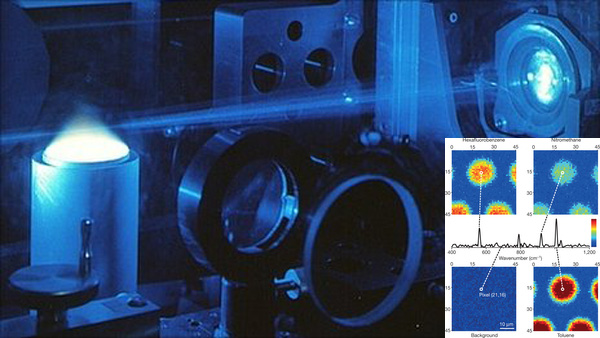Technique to Identify Individual Molecules in Realtime


(Inset) Each of the 2,025 pixels of the hyperspectral cube corresponds to a spectrum at 10 cm−1 apodized resolution measured within 12 μs at a fixed spatial location and provides the spectral signature of compounds present.
Scientists from Germany and France are reporting on a new method of identifying individual molecules in real time. Imagine being able to look at individual molecules in microseconds intervals and differentiate them. This is what a new method described by the team of European researchers is promising to do. Using coherent Raman spectro-imaging with two laser frequency combs (rapidly fluctuating laser pulses), the researchers were successful in identifying different molecular species based on their vibrational energy levels. It takes researchers one step further to realtime label-free biomolecular imaging at molecular levels.
The new technique was reported in Nature by Dr. Nathalie Picque and Prof. Theodor W. Hänsch of Max Plank Institute of Quantum Optics’s Laser Spectroscopy Division in collaboration with researchers at Ludwig-Maximilians-Universität Munich and the Institut des Sciences Moléculaires d’Orsay (France). Using two laser frequency combs, the researchers measured fully resolved Raman spectra from molecular specimens on microsecond timescale. The rapidly fluctuating laser pulses were the key to the success of the technique. By rapidly changing the time difference between the pump and the probe pulse, the rapid acquisition of Raman spectrum intensities are recorded using a single photodetector.
Coherent Raman spectroscopy since its discovery has been used to circumvent fluorescent dye label free imaging. It provides the spectroscopic characterization of the vibrational energy levels of molecules. They also allow for high spatial resolution 3D sectioning capability by exploiting near-infrared or visible lasers. Previously they have been used to imagine single color bands at video rates biological tissues. However, until now researchers couldn’t use coherent Raman spectroscopy for the analysis of complex mixtures since the existing techniques were too slow to differentiate the spectrum of mixed molecules. Imaging a complex molecular mixture theoretically required broad spectral bandwidth and high resolution, something that was overcome using frequency swept laser beams and multichannel detection.
The researchers aim to make real-time hyperspectral imaging possible by replacing the photodectector with a camera. They hope that this technique will enable new applications in both linear and non-linear spectroschopic techniques.
Also check out: New Method Allows Researchers to Observe Molecules Moving Inside Living Cells

